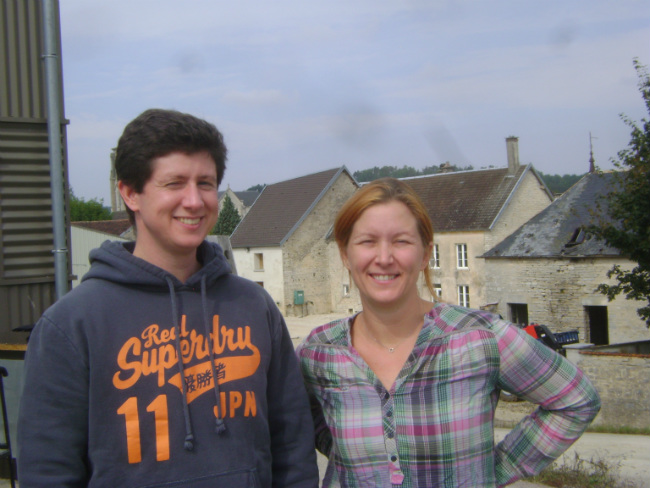Behind the Vines in Champagne: Voices of the Vignerons
There are many advantages to living in the only part of the world where real champagne is made. One of them is that the champagne here is abundant, of excellent quality, and moderately priced. Another is that, for these reasons, at nearly every social event, whether in private homes or public venues, champagne tends to flow freely. There is absolutely no sense of parsimony about champagne in this part of the world. It is a natural and ever-present part of the culinary scene, and there is something wonderful about that.
A third is that you have the opportunity to observe, and to slowly, steadily, and quite naturally learn, from year to year, just how complex the process of making champagne is, and to appreciate how deep the knowledge, respect, and love both for the land and for the fruit of the land is among the people who so carefully and painstakingly do the extensive manual labor as well as the scientific, intellectual, and artistic work that is behind every single bottle of champagne that is produced.
I live in l’Aube, which is the southernmost département in the Champagne region (now subsumed into Le Grand Est), in the Côte des Bars. This is an area that has become increasingly well known in recent years for producing a wide variety of very fine champagnes in small and medium-sized operations.
I thought it would be nice to share with readers some of the behind-the-scenes activity that goes into making champagne. And so I turned to a few friends who are involved in the making of champagne (vignerons), and asked them to share some of the things they think people should know, and might not know, about champagne and how it is made. Here are some of the highlights from their answers to my questions.
Nathalie Nourissat, Champagne Nathalie Nourissat. Growing up, Charles and Nathalie Nourissat both had family connections with the world of growing grapes for champagne, but it was not until 2015 that they decided to become vignerons themselves. The first step was for Nathalie to become legally allowed to set up a winegrowing farm, by successfully completing a one-year training program at a local agricultural technical school. Their vineyard is in Les Riceys, not far from their home in Essoyes. “We are really happy to be able to carry out our family’s legacy, and honour our heritage through the work we are doing,” Nathalie says.
“Making champagne is a rigorous and fascinating process. People often do not realize it is not just a matter of putting some strange fizzy juice into a classy bottle! The successful production of champagne begins with very serious work in the vineyard with the plant itself; and then following, on a nearly daily basis, the growing process of the plant, from the budding to maturation of the grapes. A second major part is the processing of the juice once the grapes are ‘home.’ This process is long and rigorous, as it is subject to many specific rules that are required by law. You can’t just make the champagne any way you want!”
“Despite all the difficulties and challenges, when we manage to get a superb harvest, like we did this year, it is very rewarding. When we hear our customers congratulate us on the quality of our champagne, and we know that we are able to produce this rare and luxurious, authentic, and old, and well-known festive product—and know that it will be enjoyed by people all over the world, and that they will have it to help celebrate the great events of their lives, that is wonderful.”
Bethsabée Roger, co-manager, Pressoir Roger. Jacques Roger came from a long line of farmers. In the 1970s he made the shift from diversified farming to winegrowing, and in the late 1980s, he established a pressoir (winepress) in Essoyes. After his death in 2002, his two daughters, Bethsabée and Léa, took charge of the business and built a new building for the pressoir, just steps away from the old family home. “We have done our best to keep our father’s company going, and to strengthen it,” says Bethsabée.
“There are abbreviations on bottles of champagne: R, M, N. ‘R’ means Récoltant (winegrower). That is us! We grow the grapes but we do not make our own champagne. ‘M’ means Manipulant: these are people who make and market champagne under their own label. An ‘RM’ is somebody who makes and markets champagne under his or her own label by using only grapes from their own vineyards. And ‘N’ means Négociant. Négociants buy grapes; “must” (freshly crushed grape juice); bottles of champagne at various stages of the production; or wine to make champagne on their own premises. Then they market it under their own labels. All of the major champagne companies are ‘NM’…

Bethsabée and Léa Roger at their pressoir in Essoyes
“The work in the vineyards is still mostly manual, even the picking of the grapes during the grape harvest. Champagne bottles are kept for minimum of 18 to 24 months, during which time a number of special activities, such as ‘disgorgement’ are completed before the champagne is ready to be sold. Whenever you buy a bottle of champagne, it is ready to be drunk! Except for vintage champagnes, which can be kept for longer periods of time, it is best to drink champagne within 2-3 years after purchase. Unlike some red wines, champagne doesn’t age once it is in the final bottle… The most rewarding thing for us is when the grape harvest is of the best possible quality, as then we know it will make fantastic champagne–of which we will all be very proud.”
Jennifer Fluteau grew up in Oak Park, Illinois, but when she married Thierry Fluteau in 1987, she became part of a vigneron family. Champagne Fluteau, in Gyé-sur-Seine, was founded in 1935 by Thierry’s grandfather and great-grandfather. Today Thierry and Jennifer, and their son Jeremy, are carrying on the family business.
“My job is to handle all of the administrative and bureaucratic tasks, of which there are many, this being France! That is, I do sales, customer service, marketing, export, and I am the tasting room manager. I even cook for the vendengeurs during the harvest…

Photo courtesy of Champagne Fluteau
“What do I think people should know? That real champagne only comes from Champagne, in France. Also, that the production process is highly regulated and all producers must adhere to certain rules. For example, all grapes must be hand picked; all champagne is bottle-fermented, and each bottle must be aged a minimum of 15 months; and a minimum of three years for vintages. Also, the champagne made here in the Aube is mostly Pinot Noir-based: this, combined with our more clay-based soil and somewhat warmer climate, make for richer, more full-bodied, and fruitier champagnes than the ones that come from further north in the Champagne region.
“The most difficult challenge is living with the uncertainty of the climate: late spring frosts, hailstorms, or diseases can wipe out an entire harvest. Marketing a small winery in Champagne is also a challenge, as so many people associate champagne only with the big-name brands. Champagne is often considered a status buy, and not necessarily a wine to pair with a meal, or to drink purely for pleasure. Truly, champagne is one of those small luxuries anyone can afford once in a while.”
Share to: Facebook Twitter LinkedIn Email
More in champagne
Leave a reply
Your email address will not be published. Required fields are marked *








